Last updated: December 15, 2023
Article
Aquatic Citizen Science at Mount Rainier
Amphibian Monitoring & Dragonfly Mercury Project
Mount Rainier National Park encompasses 236,381 acres in Washington State and supports a wide range of ecosystems. Many of these ecosystems are aquatic, with approximately 385 lakes and over 400 streams in the park. The lakes, streams, ponds, and wetlands of Mount Rainier provide crucial habitats to amphibian species, many of whom spend much of their lives in or near water and depend on healthy aquatic environments. Stressors associated with climate change such as increased water temperatures, decreased water quality, and drier conditions can negatively impact amphibians. Amphibian abundance therefore not only sheds light on the status of certain species but can also serve as an indicator of water quality and overall ecosystem health.
Fourteen amphibian species are known to occur in the park, including nine salamanders and five frogs. One species of particular interest is the western toad (Anaxyrus boreas), currently a candidate species for listing by Washington State. The western toad is considered rare within Mount Rainier and is actively monitored.

NPS Photos
What are we doing?
With the help of citizen scientist volunteers, we monitor amphibian populations throughout Mount Rainier, concentrating our efforts at sites where western toads are known to occur. We document the timing in life stages of western toads and note changes in sensitive breeding habitats like ephemeral wetlands and areas of high visitation adjacent to trails.
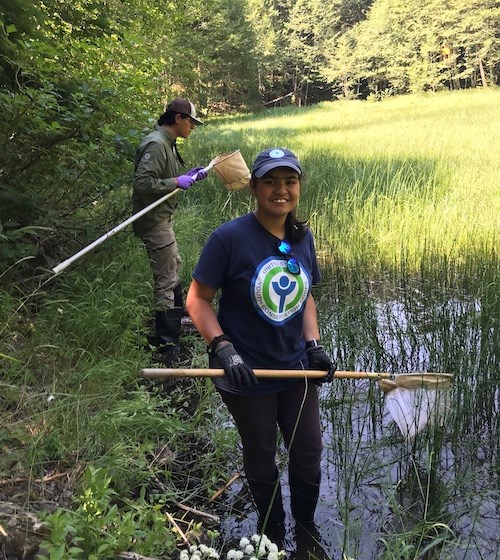
NPS Photo
Dragonfly Mercury Project
In 2014, Mount Rainier began participating in the Dragonfly Mercury Project, a nationwide effort by the US Geological Survey in conjunction with the National Park Service and other partners to monitor levels of environmental mercury across the country. As predators, dragonfly larvae accumulate mercury in their bodies from prey animals, offering a snapshot of mercury concentrations in the wetland ecosystem in which they occur. In 2023, 32 volunteers participated in the collection of dragonfly larvae at three sites in Mount Rainier. The data collected by citizen scientists will help policy makers and resource managers make informed decisions to reduce mercury impacts to public health and wildlife.
Monitoring Objectives
-
Engage volunteers in environmental science through active participation in field data collection.
-
Monitor amphibian populations, particularly western toads, throughout the park.
-
Provide data to the National Park Service on the status of aquatic environments and dependent species within Mount Rainier.
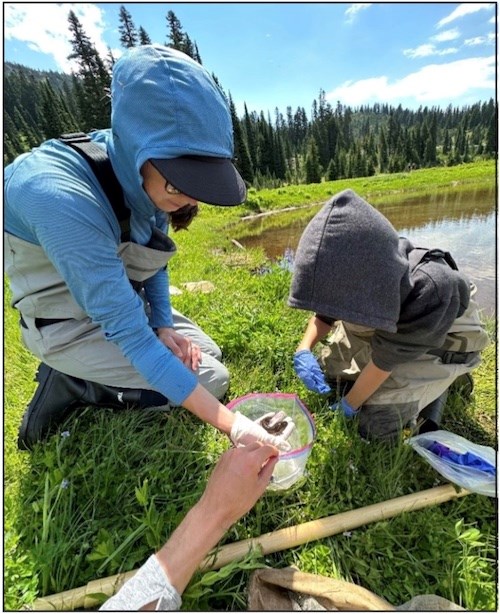
NPS Photo
Results: Volunteer Involvement
Since the establishment of the aquatic citizen science program in 2009, over 300 volunteers have contributed approximately 5,000 hours to the program. Volunteers represent a wide range of ages, backgrounds, and experience levels in both data collection and the outdoors. While day-hiking and backpacking on extended trips, volunteers have observed thousands of amphibians, as well as monitored toad development at several sites. Volunteers have also contributed to our knowledge of toxins in the park’s lakes and wetlands by collecting samples for the Dragonfly Mercury Project. After a 3-year hiatus, the program resumed in 2023 with a record number of volunteers.
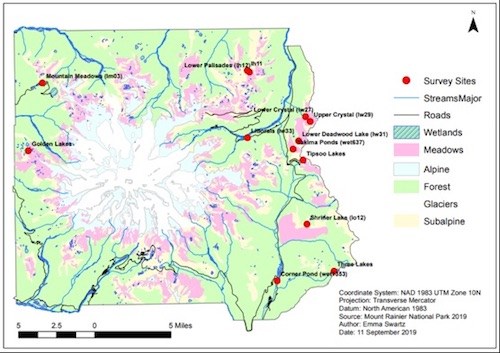
NPS Graphic
Results: Amphibian Monitoring
Volunteers have documented eight species of amphibians (three salamanders and five frogs) at 196 sites between 2009 and 2023. Furthermore, with the help of the citizen science program, the park has recently identified two new western toad breeding sites. Potential climate change impacts to toads were also documented, including decreased water availability in wetland habitats and tadpole mortality resulting from drier conditions. Additionally, we have observed that newly metamorphosed toads at higher elevation sites are substantially smaller than those at lower elevation sites, which may impact survivorship through their first winter. These clues to the status of amphibians and their habitats, and in particular western toads, can help park managers more strategically study and protect amphibians in a changing climate and in areas of high visitor use.
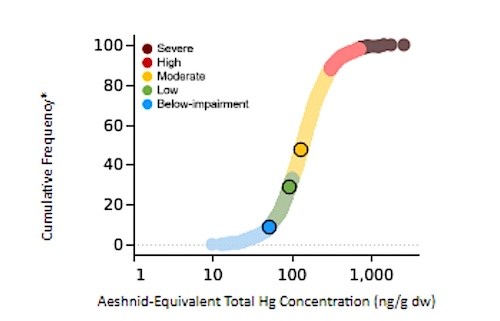
Results: Dragonfly Mercury Project
Figure 5 shows the Integrated Impairment Index for three sites sampled in 2021 at Mount Rainier. This index classifies mercury concentrations based on benchmarks for fish, wildlife, and human health risk. For more details see the park-specific annual data fliers.
*Cumulative Frequency indicates the percent of sites across all parks that have lower Hg concentrations than each of the highlighted sites (Eagles-Smith et al. 2020).
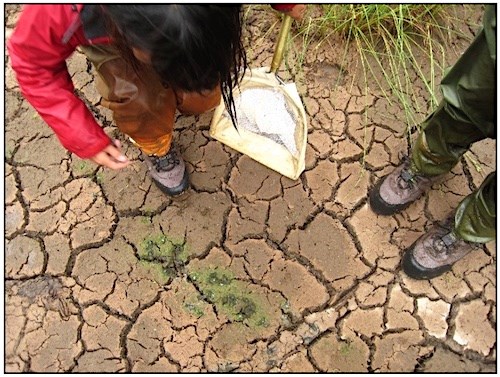
NPS Photo
2023 Accomplishments
-
A record 53 volunteers participated in the 2023 aquatic citizen science program.
-
Documented early wetland drying at Western Toad breeding sites and associated impacts to tadpole survival.
-
Dragonfly larvae were collected at three sites for the Dragonfly Mercury Project.
